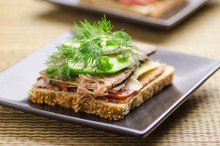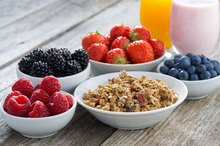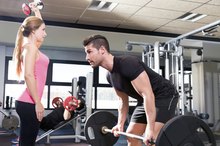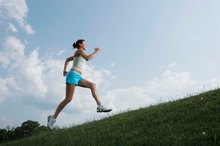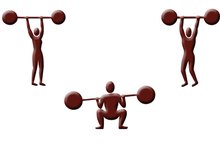What does fact checked mean?
At Healthfully, we strive to deliver objective content that is accurate and up-to-date. Our team periodically reviews articles in order to ensure content quality. The sources cited below consist of evidence from peer-reviewed journals, prominent medical organizations, academic associations, and government data.
- Fiziol Cheloveka: Acute Testosterone and Cortisol Responses to High Power Resistance Exercise
- Fiziol Cheloveka: Acute Testosterone and Cortisol Responses to High Power Resistance Exercise
- European Journal of Applied Physiology: Acute Hormonal and Neuromuscular Responses to Hypertrophy, Strength and Power Type Resistance Exercise
- European Journal of Applied Physiology: Acute Hormonal and Neuromuscular Responses to Hypertrophy, Strength and Power Type Resistance Exercise
- Journal of Steroid Biochemistry: Decrease of Serum Total and Free Testosterone During a Low-Fat High-Fibre Diet
- Journal of Steroid Biochemistry: Decrease of Serum Total and Free Testosterone During a Low-Fat High-Fibre Diet
- Dietary Omega-3 Fatty Acid Supplementation Increases the Rate of Muscle Protein Synthesis in Older Adults: a Randomized Controlled Trial
- Dietary Omega-3 Fatty Acid Supplementation Increases the Rate of Muscle Protein Synthesis in Older Adults: a Randomized Controlled Trial
- The Effects of Short-term Resistance Training on Endocrine Function in Men and Women
- The Effects of Short-term Resistance Training on Endocrine Function in Men and Women
The information contained on this site is for informational purposes only, and should not be used as a substitute for the advice of a professional health care provider. Please check with the appropriate physician regarding health questions and concerns. Although we strive to deliver accurate and up-to-date information, no guarantee to that effect is made.
Testosterone grows your muscles and revs your metabolism. High levels of testosterone contribute indirectly to your ability to sprint 13. And with the right training and diet, you can make sure your testosterone levels are at their peak at all times. This will allow you to not only become stronger, but recover faster. Consult your physician before beginning any diet or exercise program.
Effects of Testosterone
Testosterone is a steroidal hormone secreted by the testes in men and the adrenal glands in women, but men produce approximately 10 times more testosterone than women. Testosterone is the primary anabolic hormone, or the hormone most responsible for the growth of muscle tissue. Even if you are not trying to grow muscle, low levels of testosterone can make it difficult for you to retain the muscle you do have, which not only gives you less power when you run, but also slows your metabolism.
Training Effects on Hormone Production
Carbohydrates & Testosterone
Learn More
Sprinting itself has no effect on testosterone, unless you overtrain, in which case your testosterone levels drop. However, training at high intensities with short rest intervals gives your testosterone levels a brief boost without elevating cortisol levels. It is desirable to keep cortisol levels low, as cortisol is a hormone responsible for muscle wasting and fat storage.
Keeping Your Testosterone Levels Up
Diet is the primary method of ensuring that your endocrine system -- partially responsible for testosterone production -- operates optimally. A diet too low in fat will cause your levels to drop. Fat provides your body with cholesterol and other dietary sterols that your body converts into steroidal hormones, such as testosterone 3. Omega-3 and omega-6 fatty acids are particularly critical, and these can be found in oily fish such as salmon, flax, nuts and seeds. If you have trouble getting these foods in your diet, fish oil and flax oil can be supplemented in liquid or capsule form.
- Diet is the primary method of ensuring that your endocrine system -- partially responsible for testosterone production -- operates optimally.
- Fat provides your body with cholesterol and other dietary sterols that your body converts into steroidal hormones, such as testosterone 3.
Heavy Resistance Training
Lack of Sleep & Bodybuilding
Learn More
Additional training can increase your strength as well as increase your testosterone levels. Heavy resistance training with exercises such as squats build some of your sprinting muscles 5. This training should be performed the way you run: short and intense 5. Train with at least 75 percent of your one-repetition maximum, and keep your rest periods short, no more than 90 seconds, to get the maximal response from your endocrine system. Between lifting and running, the only other thing you need to do is rest and recover.
- Additional training can increase your strength as well as increase your testosterone levels.
- Between lifting and running, the only other thing you need to do is rest and recover.
Related Articles
References
- Fiziol Cheloveka: Acute Testosterone and Cortisol Responses to High Power Resistance Exercise
- European Journal of Applied Physiology: Acute Hormonal and Neuromuscular Responses to Hypertrophy, Strength and Power Type Resistance Exercise
- Journal of Steroid Biochemistry: Decrease of Serum Total and Free Testosterone During a Low-Fat High-Fibre Diet
- Dietary Omega-3 Fatty Acid Supplementation Increases the Rate of Muscle Protein Synthesis in Older Adults: a Randomized Controlled Trial
- The Effects of Short-term Resistance Training on Endocrine Function in Men and Women
Resources
- Nancy Clark's Sports Nutrition Guidebook; Nancy Clark
- Training for Speed, Agility, and Quickness; Lee E. Brown
Writer Bio
Eric Brown began writing professionally in 1990 and has been a strength and conditioning coach and exercise physiologist for more than 20 years. His published work has appeared in "Powerlifting USA," "Ironsport" and various peer-reviewed journals. Brown has a Bachelor of Science in exercise physiology from the University of Michigan and a Master of Science in kinesiology from the University of California, Los Angeles.



